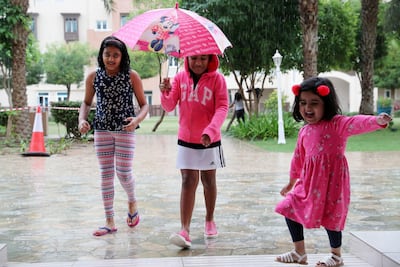The UAE recorded only 1.2 millimetres of rain in the first three months of the year, highlighting the importance of the government's long-term strategy to improve water security.
Official figures from the National Centre of Meteorology (NCM) showed that over the past six months the country had less than a fifth of the rainfall it would typically expect.
From October to March there was 7.73mm of rain, which is less than 19 per cent of the long-term average of about 41mm for Abu Dhabi in the same six-month period.
While there is no evidence that the recent drop in precipitation is the direct result of climate change, the figures tie in with a trend for reduced rainfall that researchers said will continue.
The figures demonstrate why the UAE is pushing ahead with plans to embrace new technologies – such as vertical farms – to reduce water dependence.
Norway-based climate expert Dr Nasser Karami said there was already evidence that rainfall levels in the region had fallen, a trend that threatened to put pressure on agriculture and water supplies.
“The rainfall in the Middle East and the Emirates will decrease and has decreased. But it will decrease further,” Dr Karami, who holds a doctorate in climatology, said.
'Agriculture has to change'
Dr Karami, a former associate professor at the Norwegian University of Science and Technology, who is writing a book on how climate change will affect parts of the region, said nations in the Middle East should accept that a drier future was “their destiny” and adapt accordingly.
“All of them will get more dry years,” he said. “Some countries, they have to accept they have to decrease their dependence on natural resources.”
One forecast, made by researchers in 2019, is that rainfall in the Middle East and North Africa between 2040 and 2069 will be 10 to 20 per cent less than what it was between 1961 and 1990.
“They have to adapt their life to water shortages … It will spread desertification, soil erosion. It will impact on, for example, sandstorms,” Dr Karami said.
“Agriculture has to change now in the Middle East – their cultivation pattern, their models of irrigation.”
Echoing this, Julien Jreissati, programme director for Greenpeace Mena, described the Middle East as “one of the most vulnerable regions to climate change” because of water scarcity and faster-than-average temperature increases.
“Agriculture will have to adjust to less water requirements,” he said. “You will have to change your crop types. The face of agriculture in the region will definitely change.”
About half the UAE’s water supply comes from groundwater, but extraction, particularly for agriculture, and lack of replenishment has caused the water table to fall.
At 550 litres per day, according to one report, the UAE’s per person water consumption is well above the global average of about 200 litres.
One suggestion from researchers is for further investments to be made in hydroponic agriculture, a way of growing crops without soil.
With some crops, such as lettuce, water use can be reduced by as much as 95 per cent.
Racks of growing crops can be produced one on top of the other, so yields for a given area of land can be much greater, although lighting and climatic control mean that energy use increases.
In January 2020, the UAE was hit by flooding that led to school closures and residential damage that the then environment minister said was likely linked to climate change.
Despite such events, Dr Karami said the UAE was likely to become increasingly water stressed and would have to consider new ways to secure supplies that would not cause environmental harm to Gulf waters.
As well as groundwater, much of the country’s freshwater comes from desalination, but the process has been blamed for making the region's water increasingly salty. This also makes the desalination process more difficult.
“I don’t think they have another solution better than desalination, but they have to find a way that has less impact on, for example, the sea,” Dr Karami said.
UAE takes steps to bolster water security











Last year, Abu Dhabi Investment Office provided $100 million (Dh367m) to partner agricultural technology companies AeroFarms, Madar Farms, RNZ and RDI to build agritech research and development facilities, and production centres in Abu Dhabi.
Their aim is to explore how countries with an arid climate can benefit from these technologies.
"Agritech will help to increase our domestic food production while minimising the use of water, one of the scarcest resources in our region,” said Mariam Al Mheiri, Minister of State for Food Security.
The minister has stated that vertical farms were key to preserving water resources.
"Generally, vertical farming uses 90 per cent less water than traditional farming," Ms Al Mheiri said.
"Reducing water consumption through vertical farms can also have a very positive economic and environmental impact.
How the UAE is getting drier
The NCM's figures for rainfall in the UAE for the past six months:
October 2020: 2.43mm
November 2020: 2.8mm
December 2020: 1.3mm
January 2021: 0.9mm
February 2021: 0.3mm
March 2021: 0.0mm
Total for the six months: 7.73mm
These are the NCM's average figures for Abu Dhabi Corniche for 2003-2020, to the nearest quarter of a millimetre:
October: 0mm
November: 2.75mm
December: 12.75mm
January: 10.75mm
February: 4mm
March: 10.75mm
Total for the six months: 41mm
























